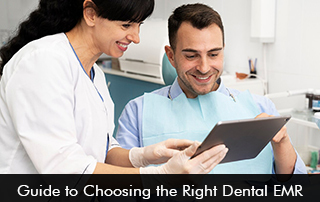In 2025, Electronic Medical Records (EMR) and Electronic Health Records (EHR) software have evolved into foundational tools for dental practices. These advanced systems streamline clinical documentation, improve patient outcomes, and simplify everything from scheduling to billing. In an era of increasing patient expectations and regulatory complexity, EMR software is no longer optional—it’s essential.
As practices continue to grow and adapt to post-pandemic digital demands, investing in the right EHR software is a strategic decision that can significantly impact both clinical quality and operational performance.
The Vital Role of Dental EMR Software Today
- Modern dental EMR software goes beyond just storing patient records.
- Enables seamless communication between dental staff and departments.
- Automates administrative tasks such as scheduling, billing, and documentation.
- Assists practices in maintaining compliance with HIPAA and other healthcare regulations.
- Offers advanced features like AI-powered analytics for clinical and operational insights.
- Provides cloud-based data access, allowing secure, real-time access from any location.
- Includes real-time patient engagement tools like appointment reminders and digital intake forms.
Transforms dental care into a more precise, efficient, and patient-centered experience. With the advent of AI-driven analytics, cloud-based solutions, and integrated patient engagement tools, dental EMR software is revolutionizing the way dental professionals manage their practices. Implementing the right dental EMR or EHR software can lead to improved patient outcomes, reduced administrative burdens, and increased profitability.
Key Features to Look for in Dental EMR Software
When selecting a dental EMR or EHR software, consider the following essential features:
-
Customizable Templates:
Look for software offering built-in templates tailored to various dental specialties such as endodontics, periodontics, orthodontics, and prosthodontics. This customization facilitates efficient documentation and streamlined workflows.
-
Integrated Billing and Coding:
Ensure the software supports ICD/CPT codes specific to dentistry, enabling accurate billing and efficient claims processing.
-
Cloud-Based Access:
Opt for cloud-based solutions that provide secure, real-time access to patient records from any location, enhancing flexibility and collaboration among dental teams.
-
AI-Driven Analytics:
Advanced analytics can offer insights into patient retention, revenue forecasting, and operational efficiencies, aiding in data-driven decision-making.
-
Patient Engagement Tools:
Features like online appointment scheduling, automated reminders, and digital forms improve patient experience and reduce no-shows.
-
Compliance and Security:
The software should be HIPAA-compliant, ensuring patient data is protected through encryption and secure access controls.
Top 5 Dental EMR Software Recommended
Based on industry reviews and user feedback, here are five leading dental EMR software solutions widely recommended:
-
Dentrix
- Developed by Henry Schein, Dentrix is a comprehensive dental practice management software that integrates clinical and administrative functions.
- Features include intuitive patient charting, appointment scheduling, billing, and imaging integration.
- Its robust reporting tools assist in tracking practice performance and identifying growth opportunities.
- Dentrix’s scalability makes it suitable for both small practices and large dental organizations.
-
Open Dental
- Open Dental is an open-source dental practice management software known for its flexibility and affordability.
- It offers customizable charting, billing, and appointment modules, catering to various practice needs.
- The software supports electronic prescriptions, imaging, and integrates with numerous third-party applications.
- Its active user community contributes to continuous improvements and support.
-
Curve Dental
- Curve Dental is a cloud-based dental software solution designed for modern practices seeking mobility and ease of use.
- It provides features like digital charting, patient scheduling, billing, and imaging, all accessible via web browsers.
- The platform emphasizes user-friendly interfaces and real-time data access, enhancing team collaboration.
- Regular updates and dedicated customer support ensure the software evolves with practice needs.
-
Eaglesoft
- Developed by Patterson Dental, Eaglesoft combines clinical and business management tools in a single platform.
- It features comprehensive charting, imaging, treatment planning, and financial modules.
- The software’s intuitive design simplifies staff training and daily operations.
- Eaglesoft’s integration capabilities allow seamless connection with various dental technologies.
-
CareStack
- CareStack is a cloud-based dental software solution offering an all-in-one platform for practice management, clinical care, and patient engagement.
- Its features include scheduling, charting, billing, analytics, and telehealth capabilities.
- The software supports multi-location practices, providing centralized control and reporting.
- CareStack’s modular design allows practices to customize functionalities based on specific requirements.
Selecting the right dental EMR or EHR software is crucial for enhancing patient care, improving operational efficiency, and ensuring regulatory compliance. By focusing on key features such as customizable templates, integrated billing, cloud-based access, AI-driven analytics, patient engagement tools, and robust security measures, dental practices can make informed decisions that align with their unique needs. The top software solutions highlighted—Dentrix, Open Dental, Curve Dental, Eaglesoft, and CareStack—offer diverse functionalities catering to various practice sizes and specialties. Investing in the appropriate dental EMR software will position your practice for sustained success in the evolving landscape of dental healthcare.








